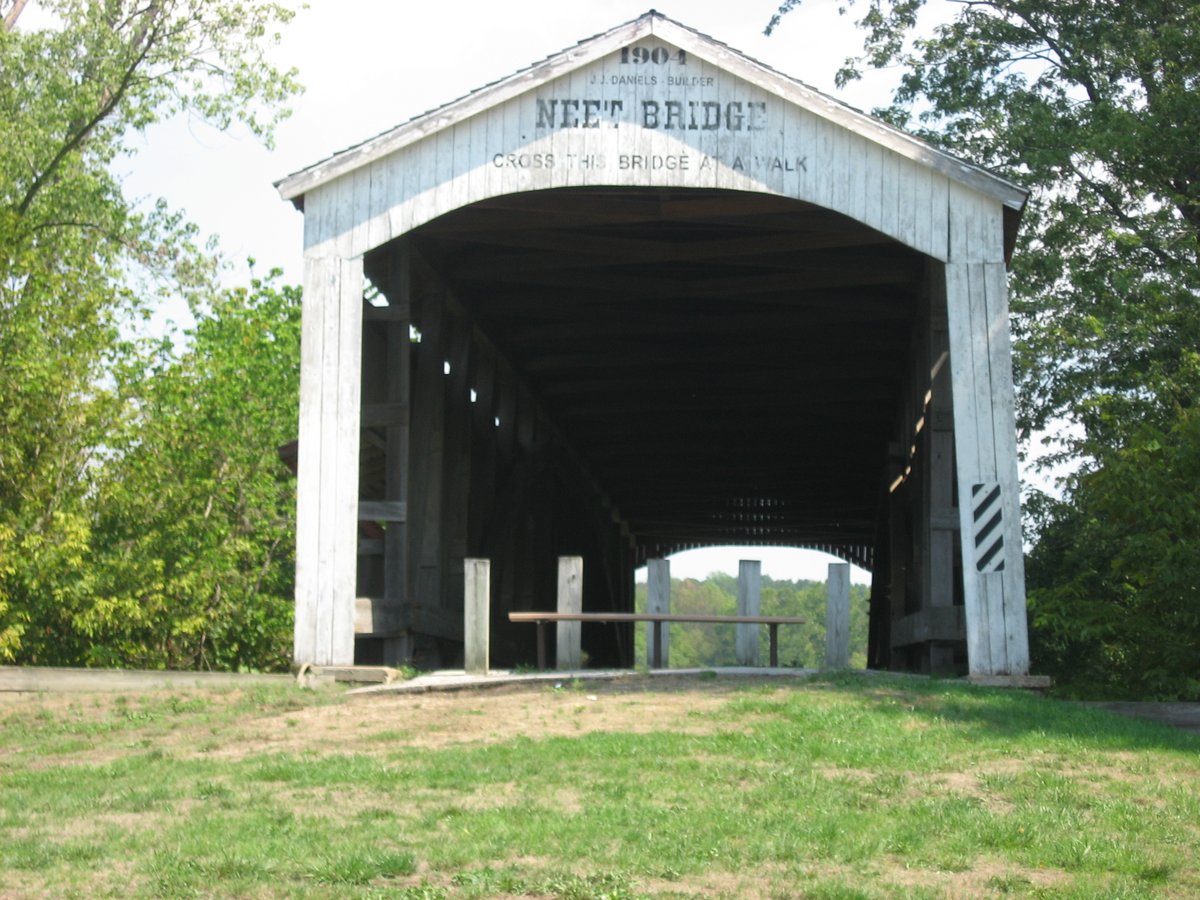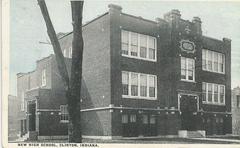
Visiting Neet Covered Bridge: History, Tips, and Visitor Information
Date: 01/08/2024
Introduction
Nestled in the picturesque Parke County, Indiana, the Neet Covered Bridge stands as a testament to the rich heritage and architectural ingenuity of the early 20th century. Constructed by the renowned bridge builder Joseph J. Daniels in 1904, this Burr Arch single-span structure not only facilitated transportation over Little Raccoon Creek but also became a symbol of community pride and historical significance. The bridge’s inclusion in the National Register of Historic Places in 1978 underscores its importance (Wikipedia). This comprehensive guide delves into the Neet Covered Bridge’s fascinating history, architectural marvels, visitor information, and cultural impact, providing a thorough understanding for anyone planning to explore this iconic landmark.
Table of Contents
- [Introduction](#introductionintroduction)
- [Historical Background](#historical-backgroundhistorical-background)
- [Architectural Significance](#architectural-significancearchitectural-significance)
- [Visitor Information](#visitor-informationvisitor-information)
- [Visiting Hours](#visiting-hoursvisiting-hours)
- [Ticket Information](#ticket-informationticket-information)
- [Contribution to Transportation History](#contribution-to-transportation-historycontribution-to-transportation-history)
- [Joseph J. Daniels’ Legacy](#joseph-j-daniels-legacyjoseph-j-daniels-legacy)
- [Preservation Efforts](#preservation-effortspreservation-efforts)
- [Cultural Impact](#cultural-impactcultural-impact)
- [Nearby Historical Landmarks](#nearby-historical-landmarksnearby-historical-landmarks)
- [Community Significance](#community-significancecommunity-significance)
- [Educational Value](#educational-valueeducational-value)
- [Challenges and Future Prospects](#challenges-and-future-prospectschallenges-and-future-prospects)
- [FAQ](#faqfaq)
- [Conclusion](#conclusionconclusion)
- [Call to Action](#call-to-actioncall-to-action)
Historical Background
The Neet Covered Bridge, located in Parke County, Indiana, is a Burr Arch single-span structure built by Joseph J. Daniels in 1904 over Little Raccoon Creek, southwest of Rockville, Indiana. This bridge is a significant part of the county’s rich heritage of covered bridges, which are celebrated annually during the Parke County Covered Bridge Festival. The bridge was added to the National Register of Historic Places in 1978, underscoring its historical importance (Wikipedia).
Architectural Significance
The Neet Covered Bridge is a testament to the engineering and architectural practices of the early 20th century. The Burr Arch design, which combines the strength of an arch with the simplicity of a truss, was a popular choice for covered bridges during this period. This design not only provided the necessary support for the bridge but also allowed it to span greater distances without the need for additional piers in the water, which could be susceptible to damage from floods and ice (Travalour).
Visitor Information
Visiting Hours
The Neet Covered Bridge is accessible year-round, offering visitors a chance to explore its beauty and historical significance at any time. However, the best time to visit is during daylight hours for safety and optimal viewing.
Ticket Information
There is no admission fee to visit the Neet Covered Bridge, making it an affordable and educational outing for families and history enthusiasts alike. During the Parke County Covered Bridge Festival, special events and guided tours may be available, offering deeper insights into the bridge’s history and significance.
Contribution to Transportation History
The construction of the Neet Covered Bridge played a pivotal role in the development of transportation in Parke County. During the late 19th and early 20th centuries, covered bridges were essential for facilitating travel and commerce in rural areas. They provided reliable crossings over rivers and streams, which were often impassable during periods of high water. The Neet Covered Bridge, in particular, was crucial for connecting communities and supporting the local economy (Travalour).
Joseph J. Daniels’ Legacy
Joseph J. Daniels, the builder of the Neet Covered Bridge, was a prominent bridge builder in Indiana. Born in 1826, Daniels constructed numerous covered bridges throughout his career, many of which still stand today. The Neet Covered Bridge was his last contracted project, completed when he was 78 years old. Daniels’ work is characterized by its durability and aesthetic appeal, making his bridges not only functional but also visually pleasing (Wikipedia).
Preservation Efforts
The inclusion of the Neet Covered Bridge in the National Register of Historic Places has helped ensure its preservation. This designation recognizes the bridge’s historical and architectural significance and provides protections against demolition or inappropriate alterations. Preservation efforts have included regular maintenance and repairs to address wear and tear, ensuring that the bridge remains a safe and functional part of the local infrastructure (Wikipedia).
Cultural Impact
The Neet Covered Bridge is more than just a piece of infrastructure; it is a cultural landmark. Covered bridges are often romanticized in American culture, symbolizing a simpler, more pastoral way of life. The Neet Covered Bridge, with its picturesque setting and historical significance, attracts visitors from around the country, contributing to the local tourism industry. The annual Parke County Covered Bridge Festival, which celebrates the county’s 31 covered bridges, draws thousands of visitors each year, highlighting the cultural importance of these structures (Travalour).
Nearby Historical Landmarks
The Neet Covered Bridge is part of a network of historical landmarks in Parke County. Nearby covered bridges, such as the McAllisters Covered Bridge (1.03 km away), Nevins Covered Bridge (2.25 km away), and Crooks Covered Bridge (2.59 km away), each have their own unique histories and architectural features. These bridges collectively contribute to the area’s rich heritage and offer visitors a comprehensive view of the region’s historical landscape (Travalour).
Community Significance
For the local community, the Neet Covered Bridge is a symbol of their shared history and heritage. It represents the ingenuity and hard work of past generations and serves as a reminder of the importance of preserving historical structures. Community events, such as the Parke County Covered Bridge Festival, help foster a sense of pride and continuity, connecting residents with their local history and each other (Travalour).
Educational Value
The Neet Covered Bridge also serves an educational purpose. It provides a tangible link to the past, allowing visitors to learn about early engineering techniques, transportation history, and the cultural significance of covered bridges. Educational programs and guided tours often include the Neet Covered Bridge as a key point of interest, helping to educate the public about the importance of historical preservation (Travalour).
Challenges and Future Prospects
Despite its historical significance, the Neet Covered Bridge faces challenges common to many historical structures, including the need for ongoing maintenance and protection from environmental threats. Flooding, in particular, poses a risk to the bridge’s structural integrity. However, with continued preservation efforts and community support, the Neet Covered Bridge can remain a cherished landmark for future generations (Wikipedia).
FAQ
What are the visiting hours for Neet Covered Bridge?
The Neet Covered Bridge is open to visitors year-round, with daylight hours being the best time to visit for safety and visibility.
How much are the tickets for Neet Covered Bridge?
There is no admission fee to visit the Neet Covered Bridge.
Are guided tours available at Neet Covered Bridge?
Guided tours may be available during the Parke County Covered Bridge Festival, offering deeper insights into the bridge’s history and significance.
Conclusion
In conclusion, the Neet Covered Bridge is a vital part of Parke County’s historical and cultural landscape. Its architectural significance, contribution to transportation history, and role in the community make it a landmark worth preserving and celebrating. Through ongoing preservation efforts and community engagement, the Neet Covered Bridge will continue to be a source of pride and historical education for years to come.
Call to Action
For more information on visiting the Neet Covered Bridge and other historical sites in Parke County, download the Audiala mobile app, check out related posts on our website, and follow us on social media for the latest updates.
References
- Neet Covered Bridge, Wikipedia. source url
- Neet Covered Bridge, Travalour. source url

